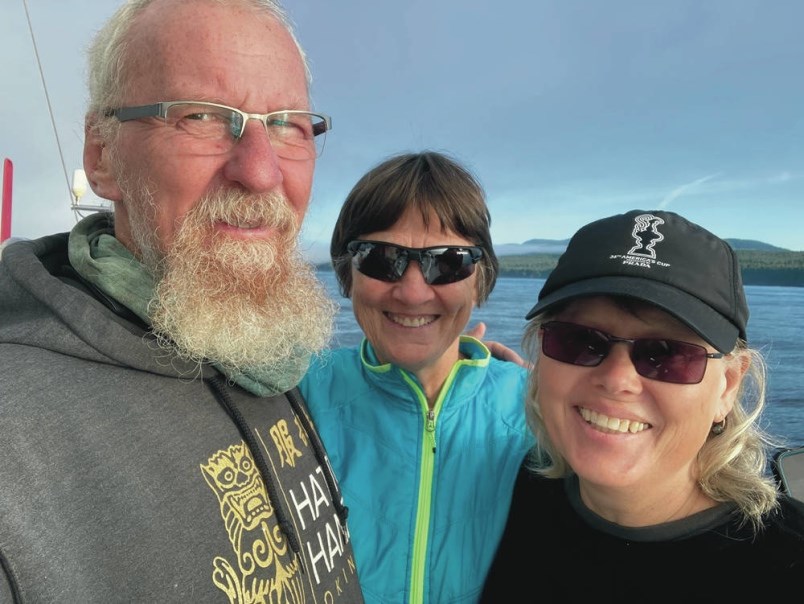So close, yet so far.
Helen Roberts and Jean Baillargeon are home after four years at sea. They are anchored off Cadboro Bay — family, friends, loved ones and solid land tantalizingly close — but they can’t get off their boat.
As the border opened to land and air travellers on Monday, the marine rules for arrival into Canada were “confusing” with no apparent guidelines or dates for a reopening.
Roberts, Baillargeon and crew member Rhonda Schuller are fully vaccinated and haven’t had any contact with other people since leaving Hawaii last month, but were told by customs agents they have to quarantine for two weeks. But even after that, it’s unclear what they have to do to clear customs.
“It’s frustrating,” Roberts said Monday.
Americans arriving by land and air Monday had to show proof of a full course of Health Canada-approved vaccines, have a negative molecular test for COVID-19 within 72 hours and use the ArriveCAN app to upload their details. So far, the U.S. has not revealed any reciprocal plans.
John Adams, a Florida resident who owns a vacation property in Barkley Sound, left Tampa Monday morning at 6:30, changed planes in Denver and then caught a connecting flight to Vancouver, scheduled to land at 3:30 p.m.
In an email, he found the process smooth and “hassle free, given the substantial requirements.”
Adams has been waging a relentless advertising campaign on travel restrictions between Canada and the U.S., and praised Prime Minister Justin Trudeau for taking the first step ahead of U.S. President Joe Biden.
Adams said he’s received messages from two Americans who crossed the border within 10 minutes of the re-opening — one at Buffalo, New York and another at the Peace Arch Crossing. “I asked both to rate their crossing on a scale of 1 to 10 and both rated it as a 10,” said Adams.
For Roberts and Baillargeon, a two-week quarantine seems unnecessary, because they’ve already been 19 days at sea without any contact. And all on board have been fully vaccinated for two months.
“The countries we have visited recognize time at sea as quarantine,” said Baillargeon. “Canada doesn’t recognize for some reason.”
Added Roberts: “We are supposed to have a [COVID] test three days before arriving, but where can you do that in the middle of the ocean?”
Baillargeon said customs agents they’ve dealt with with “understood us and kept apologizing profusely. They are following the rules given, but [the rules] don’t make sense. One also commented that the ArriveCAN app was a piece of junk.”
The couple and crew member left Victoria in 2017 aboard their 14-metre sloop Shamata and hunkered down in New Zealand when the pandemic hit. They’ve been slowly making their way home since May 4 with stops for provisions and boat repairs in Tahiti and Hawaii.
During quarantine, the couple are allowed to buy fuel and water at Oak Bay Marina, and have contact with one person, Roberts’ mother, who is supplying groceries.
While Canada opened its land borders to U.S. citizens Monday, operators of ferries between Vancouver Island and Washington state learned that their services will remain suspended.
It was devastating news for those who had been awaiting word on whether Canada would accept Americans travelling via the Clipper passenger service from Seattle and the MV Coho from Port Angeles.
Traffic in the other direction remains suspended, too — the U.S. won’t admit Canadian tourists travelling by either land or ferry; and update is expected Aug. 21.
Clipper Navigation CEO David Gudgel said he was “blindsided” by Monday’s news. With Americans making up the great majority of Clipper’s customers, having Canada open its doors to U.S. citizen was critical to his operation. He said it’s not logical to refuse entry to travellers who would be tested and pre-screened in the same way as those arriving by air. “To have ferries carved out of that was pretty frustrating.”
Ryan Burles, the president of Coho operator Black Ball Ferry Lines, agreed.
Although it doesn’t make sense for the Coho to resume sailing until it has permission from both Canada and the U.S. to carry each other’s citizens, Burles hoped Monday would at least offer an idea of what the future would hold. “We just want some sort of road map, some sort of clarity.”
Gudgel said there would come a point where it’s just not worth reopening Clipper service until next May, and worries that will bleed the company of hard-to-replace staff. “I’m going to lose a lot of highly trained, specialized people, some of whom have been with us for 30 years.”
Paul Nursery, chief executive of Destination Victoria, said lifting the land and air borders is welcome, but isn’t expecting a flood of American tourists. “To be very honest it’s a trickle,” he said, noting the U.S. ferries would have made a more considerable impact.
“On the other hand, it’s exciting that the border is re-opening and we’re able to process Americans into Canada.”
Nursey said similar to the post 9/11 period, building back U.S. tourists will take time. “You have to remember that we are in a very competitive environment,’ he said. “The U.S. traveller has lots of choices without having any borders to cross.”
A spokesman for Victoria International Airport said there hasn’t been any noticeable extra passenger traffic from the larger airports like Vancouver, Calgary or Edmonton which have been cleared to handle Amerian visitors. Rod Hunchak said “we don’t see anything major in terms of [U.S.] passengers at this point.”
The federal government is planning to allow vaccinated visitors from outside the U.S. to return to Canada for non-essential reasons as of Sept. 7.
With files from Jack Knox and The Canadian Press



